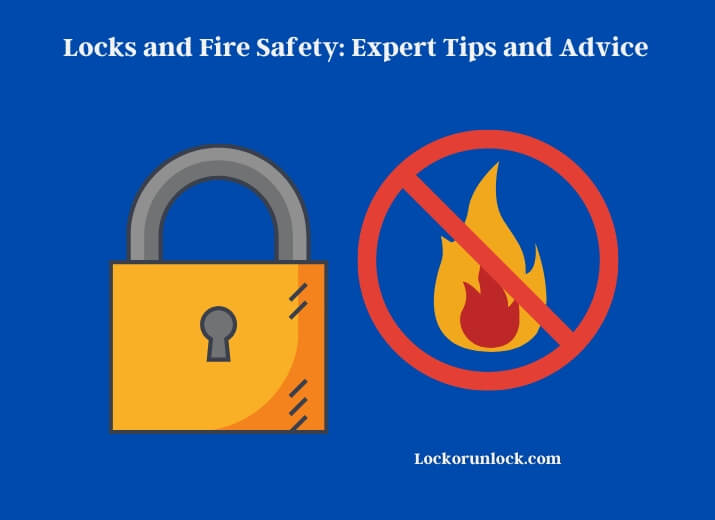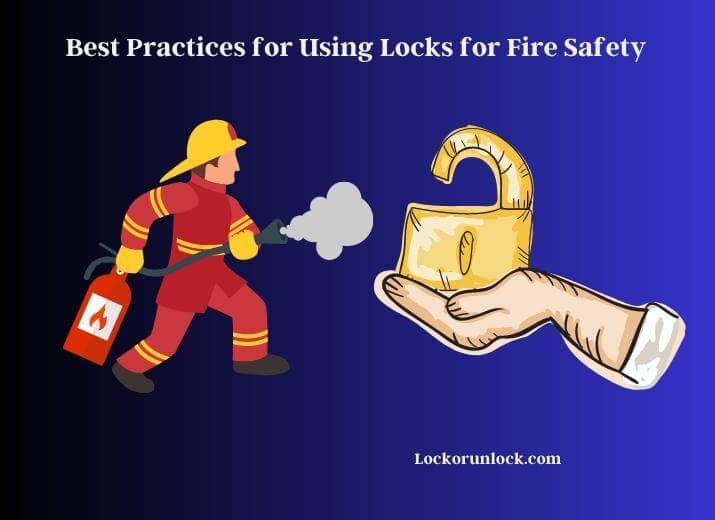Fires can be devastating, causing damage to property and even loss of life. That’s why it’s so important to take fire safety seriously and consider all aspects of it, including the role that locks play. Locks can be a crucial part of fire safety, preventing fires from spreading and giving people time to evacuate safely.

Locks can also be dangerous during a fire if they prevent people from escaping. That’s why it’s essential to understand the different types of locks and how to use them effectively for fire safety.
The Importance of Locks for Fire Safety
Locks play an essential role in preventing fires from spreading and giving people time to evacuate safely. By controlling access to certain areas, locks can help contain fires and prevent them from spreading throughout a building. For example, a locked door can prevent a fire from spreading from one room to another, giving occupants time to escape and firefighters time to contain the fire.
There are several types of locks that are commonly used for fire safety, including deadbolts, panic bars, and electromagnetic locks. Deadbolts are commonly used on exterior doors and are designed to provide extra security by preventing the door from being opened without a key. Panic bars, on the other hand, are designed to allow for easy exit in the event of an emergency. They are typically installed on doors that lead to a public area or exit, such as in a school or office building. Electromagnetic locks are used in areas where access needs to be restricted, such as in a laboratory or server room. These locks are designed to release automatically in the event of a fire, allowing people to escape quickly.
To control access to certain areas, locks can also be used to ensure that fire doors remain closed. Fire doors are designed to prevent the spread of fire and smoke by creating a barrier between different areas of a building. However, if these doors are not properly closed, they may not be effective. Locks can help ensure that these doors remain closed, preventing the spread of fire and smoke.
Locks are an important part of fire safety, and it’s essential to choose the right type of lock for your building and ensure that it is properly maintained.
If you want to know about The Future of Locks: Innovations and Advancements, see here for details.
Potential Dangers of Locks During a Fire
While locks can play an important role in fire safety, they can also pose a danger during a fire if they prevent people from escaping. If a lock is difficult to open or requires a key, it can slow down or even prevent people from evacuating the building, putting their lives at risk.
Double-Cylinder Deadbolt
One type of lock that is particularly dangerous during a fire is a double-cylinder deadbolt. This type of lock requires a key to unlock the door from both the inside and outside. While this may provide extra security, it can also be deadly during a fire. If the key is not readily available, occupants may become trapped inside the building, unable to escape.
Not Properly Maintained
If a lock is old or damaged, it may not function properly during an emergency. For example, if a panic bar is rusted or jammed, it may not release properly, preventing people from exiting the building quickly.
It’s important to note that locks are not the only potential danger during a fire. Other factors, such as blocked exits, faulty fire alarms, and inadequate evacuation plans, can also put people’s lives at risk.
To ensure that locks do not pose a danger during a fire, it’s essential to choose the right type of lock for your building and ensure that it is properly maintained. It’s also important to develop and practice an evacuation plan so that occupants know how to exit the building safely in the event of a fire. By taking these steps, you can help prevent locks from becoming a danger during a fire and keep occupants safe.
Best Practices for Using Locks for Fire Safety
When it comes to using locks for fire safety, there are several best practices to keep in mind.

Choose the Right Type of Lock
As mentioned earlier, there are several types of locks that are commonly used for fire safety, including deadbolts, panic bars, and electromagnetic locks. It’s important to choose the right type of lock for your building, based on factors such as the level of security needed and the type of occupants in the building.
Install Locks Properly
It’s essential to ensure that locks are installed properly and in accordance with local building codes. Improperly installed locks can be dangerous, preventing people from escaping during a fire.
Keep Locks Maintained
Regular maintenance is essential to ensure that locks function properly during an emergency. This may include lubricating hinges and locks, checking for rust or other damage, and replacing worn or damaged parts.
Ensure That Fire Doors Remain Closed
Fire doors are designed to prevent the spread of fire and smoke, and it’s important to ensure that they remain closed at all times. This may require the use of a latch or other device to keep the door closed.
Develop and Practice an Evacuation Plan
A well-designed evacuation plan can help ensure that occupants are able to exit the building quickly and safely in the event of a fire. This may include identifying escape routes, designating a meeting place outside the building, and practicing the evacuation plan regularly.
Consider Installing Automatic Release Mechanisms
In some cases, it may be appropriate to install automatic release mechanisms on locks, such as electromagnetic locks. These mechanisms are designed to release automatically in the event of a fire, allowing people to escape quickly.
Other Fire Safety Considerations
While locks are an important consideration when it comes to fire safety, there are several other factors to keep in mind.
Smoke Alarms
Smoke alarms are one of the most important fire safety devices, as they can alert occupants to a fire early on and provide valuable time to evacuate the building. It’s important to ensure that smoke alarms are installed throughout the building and tested regularly.
Fire Extinguishers
Fire extinguishers can be an effective tool for putting out small fires before they become major emergencies. It’s important to ensure that fire extinguishers are located in accessible areas throughout the building and that occupants know how to use them.
Evacuation Plans
A well-designed evacuation plan can be critical for ensuring that occupants are able to exit the building quickly and safely in the event of a fire. This may include identifying escape routes, designating a meeting place outside the building, and practicing the evacuation plan regularly.
Fire Drills
Regular fire drills can help ensure that occupants are familiar with the evacuation plan and know what to do in the event of a fire. It’s important to practice fire drills regularly and to evaluate the effectiveness of the evacuation plan.
Fire-Resistant Materials
Using fire-resistant materials in the construction of the building can help prevent the spread of fire and limit damage in the event of a fire. This may include using fire-resistant doors, walls, and ceilings.
Electrical Safety
Electrical fires can be a major hazard, so it’s important to ensure that electrical systems are properly maintained and that electrical equipment is used safely.
Summary
Locks are an important consideration when it comes to fire safety. While locks can help prevent unauthorized entry into a building, they can also pose a potential danger during a fire if they are not used properly. It’s essential to choose the right type of lock, install locks properly, and keep them maintained to ensure that they function properly during an emergency.
There are several other fire safety considerations to keep in mind, such as smoke alarms, fire extinguishers, evacuation plans, fire drills, fire-resistant materials, and electrical safety. If you take a comprehensive approach to fire safety and considering all of these factors, you can help prevent fires from occurring and minimize damage if they do occur.
Fire safety is everyone’s responsibility. Building owners, occupants, and managers all play a role in ensuring that a building is as safe as possible in the event of a fire. By working together and taking fire safety seriously, we can help prevent tragedies and keep our communities safe.
